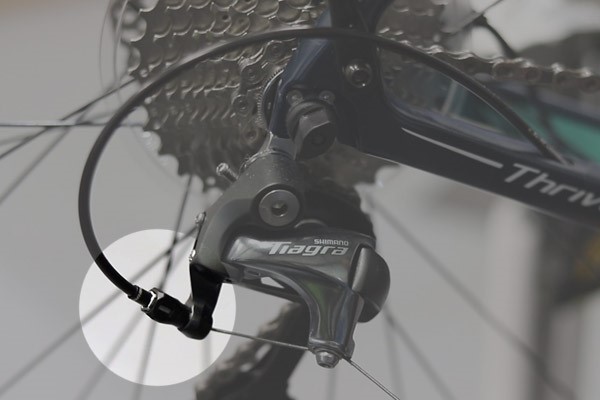After riding your new bike for a while, you might notice that your gears don’t work as smoothly as they did when you first bought it. This is usually because the gear cable has stretched slightly, so the gears are not indexed properly and don’t change smoothly.
As long as there is no damage to the derailleurs or cables, it is very easy to re-index your gears to get them changing smoothly again. Some riders can do this as they ride along, but it’s best to do it on a bike stand first time, until you are familiar with the process.
The rear derailleur is the one component that usually needs attention, so this is what we will focus on first.
1Step 1: Locate the barrel adjuster
The barrel adjuster is usually located near the shifter or on the derailleur. Road bikes often have an inline barrel adjuster on the cable.
Wherever the barrel adjuster is located, the principle for adjusting it is the same. Turning the barrel adjuster clockwise slackens the cable, turning it anti-clockwise tightens the cable. You will notice that the barrel adjuster clicks as you turn it. This is so you can turn it in even steps while adjusting.

2Step 2: Does the cable need tightening?
We need to find out whether we need to tighten or slacken the cable. Usually, on a new bike, we will need to tighten the cable, to account for the natural stretch in the cable, but we need to check to be sure.
Look at the rear cassette as you turn the pedals and use the shifter to change the gears up and down. If your chain is struggling to move up onto the larger cogs on the cassette you need to tighten the cable. If the chain is struggling to move down onto the smaller cogs you need to loosen the cable.
If the barrel adjuster is on the rear derailleur, then a handy way to think about this is to turn the barrel adjuster towards the cassette to move up onto a larger cog or turn it away from the cassette to move it onto a smaller cog.

3Step 3: Adjust the cable tension
Now that we know what the problem is, we can use the barrel adjuster to re-index the gears. Go carefully, one click at a time, when turning the adjuster, so you don’t move too far away from the original settings. Try to remember how many clicks you turn the adjuster so that you can return to the original setting if necessary.
If the chain is struggling to change up into a bigger cog, for a lower gear, then the cable is a little too slack. Turn the barrel anti- clockwise one click and try changing the gears up and down again. This should offer some improvement, but you may need one or two more clicks to get it perfect.
If the chain is struggling to change down into a smaller cog for a higher gear then the cable is too tight. Turn the barrel clockwise one click and try changing the gears up and down again. This should offer some improvement but again you may need one or two more clicks.

4Step 4: The front derailleur
The front derailleur works on the same principle but as you will use it less is much less prone to cable stretch. Just remember that, with the front derailleur the larger chainring is for the higher gears while the smaller one is for lower gears.
If your derailleur is struggling to move up into a larger chainring then you will need to tighten the cable by turning the barrel adjuster anti-clockwise. You will find the barrel adjuster on the shifter or cable.
If your derailleur is struggling to move down onto a smaller chainring then you will need to slacken the cable by turning the barrel adjuster clockwise.

This should re-index your gears so that they are working as well as they did when the bike was new.
If this doesn’t solve the problem and your gears are still not changing properly, it may mean that the cable is sticking. This is a common problem as water and dirt often finds its way in between the inner and outer cable. In this case you will need to change the inner cable and probably the outer housing too before re-indexing your gears.




